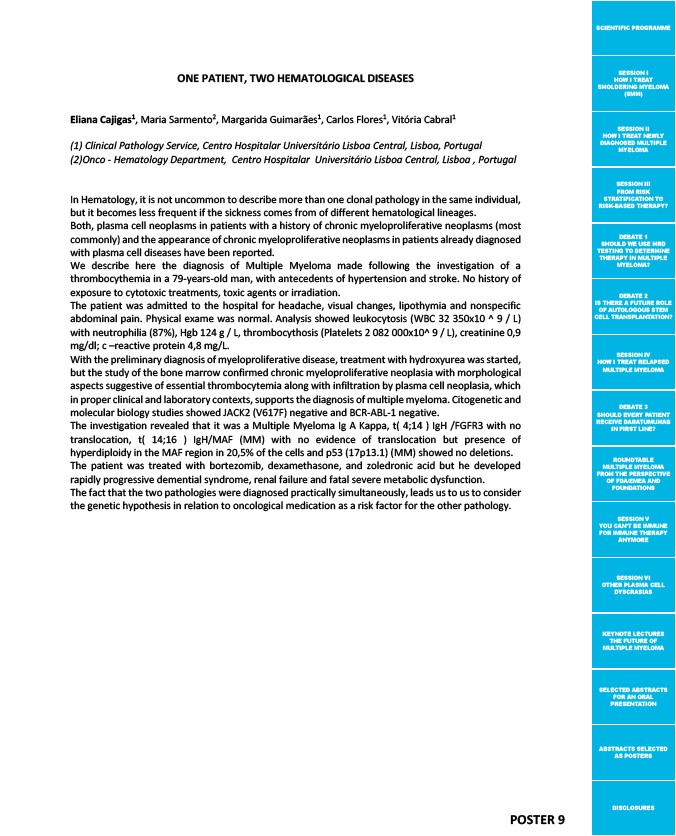
SCIENTIFIC PROGRAMME
SESSION I
HOW I TREAT
SMOLDERING MYELOMA
(SMM)
SESSION II
HOW I TREAT NEWLY
DIAGNOSED MULTIPLE
MYELOMA
SESSION III
FROM RISK
STRATIFICATION TO
RISK-BASED THERAPY?
DEBATE 1
SHOULD WE USE MRD
TESTING TO DETERMINE
THERAPY IN MULTIPLE
MYELOMA?
DEBATE 2
IS THERE A FUTURE ROLE
OF AUTOLOGOUS STEM
CELL TRANSPLANTATION?
SESSION IV
HOW I TREAT RELAPSED
MULTIPLE MYELOMA
DEBATE 3
SHOULD EVERY PATIENT
RECEIVE DARATUMUMAB
IN FIRST LINE?
ROUNDTABLE
MULTIPLE MYELOMA
FROM THE PERSPECTIVE
OF FDA/EMEA AND
FOUNDATIONS
SESSION V
YOU CAN’T BE IMMUNE
FOR IMMUNE THERAPY
ANYMORE
SESSION VI
OTHER PLASMA CELL
DYSCRASIAS
KEYNOTE LECTURES
THE FUTURE OF
MULTIPLE MYELOMA
SELECTED ABSTRACTS
FOR AN ORAL
PRESENTATION
ABSTRACTS SELECTED
AS POSTERS
DISCLOSURES
POSTER 9
ONE PATIENT, TWO HEMATOLOGICAL DISEASES
Eliana Cajigas1, Maria Sarmento2, Margarida Guimarães1, Carlos Flores1, Vitória Cabral1
(1) Clinical Pathology Service, Centro Hospitalar Universitário Lisboa Central, Lisboa, Portugal
(2)Onco - Hematology Department, Centro Hospitalar Universitário Lisboa Central, Lisboa , Portugal
In Hematology, it is not uncommon to describe more than one clonal pathology in the same individual,
but it becomes less frequent if the sickness comes from of different hematological lineages.
Both, plasma cell neoplasms in patients with a history of chronic myeloproliferative neoplasms (most
commonly) and the appearance of chronic myeloproliferative neoplasms in patients already diagnosed
with plasma cell diseases have been reported.
We describe here the diagnosis of Multiple Myeloma made following the investigation of a
thrombocythemia in a 79-years-old man, with antecedents of hypertension and stroke. No history of
exposure to cytotoxic treatments, toxic agents or irradiation.
The patient was admitted to the hospital for headache, visual changes, lipothymia and nonspecific
abdominal pain. Physical exame was normal. Analysis showed leukocytosis (WBC 32 350x10 ^ 9 / L)
with neutrophilia (87%), Hgb 124 g / L, thrombocythosis (Platelets 2 082 000x10^ 9 / L), creatinine 0,9
mg/dl; c –reactive protein 4,8 mg/L.
With the preliminary diagnosis of myeloproliferative disease, treatment with hydroxyurea was started,
but the study of the bone marrow confirmed chronic myeloproliferative neoplasia with morphological
aspects suggestive of essential thrombocytemia along with infiltration by plasma cell neoplasia, which
in proper clinical and laboratory contexts, supports the diagnosis of multiple myeloma. Citogenetic and
molecular biology studies showed JACK2 (V617F) negative and BCR-ABL-1 negative.
The investigation revealed that it was a Multiple Myeloma Ig A Kappa, t( 4;14 ) IgH /FGFR3 with no
translocation, t( 14;16 ) IgH/MAF (MM) with no evidence of translocation but presence of
hyperdiploidy in the MAF region in 20,5% of the cells and p53 (17p13.1) (MM) showed no deletions.
The patient was treated with bortezomib, dexamethasone, and zoledronic acid but he developed
rapidly progressive demential syndrome, renal failure and fatal severe metabolic dysfunction.
The fact that the two pathologies were diagnosed practically simultaneously, leads us to us to consider
the genetic hypothesis in relation to oncological medication as a risk factor for the other pathology.